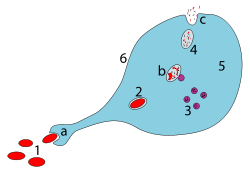Macrophage

a.Ingestion through phagocytosis, a phagosome is formed
b.The fusion of lysosomes with the phagosome; the pathogen is broken down by enzymes
c.Waste material is expelled orassimilated(the latter not pictured)
Parts:
1.Pathogens
2.Phagosome
3.Lysosomes
4.Waste material
5.Cytoplasm
6.Cell membrane
Macrophages[1]arewhite blood cellswithin tissues, produced by thedifferentiationofmonocytes.[2]
Monocytes and macrophages arephagocytes,acting in generalimmunity.They also trigger specific defense mechanisms (adaptive immunity) ofvertebrates.
Their role is tophagocytose(engulf and then digest) cellular debris andpathogenseither as stationary or as mobile cells. They also stimulatelymphocytesand other immune cells to respond to the pathogen,
Life cycle
[change|change source]When amonocyteenters damaged tissue through the wall of ablood vesselit changes to become a macrophage. Monocytes are attracted to a damaged site by chemical substances, triggered by a range of stimuli. At some sites such as the testis, macrophages have been shown to populate the organ through proliferation.
Unlike short-livedneutrophils,macrophages survive longer in the body, up to several months.
References
[change|change source]- ↑Greek:big eaters,frommakros"large" +phagein"eat"; abbr.MΦ
- ↑Human macrophages are about 21micrometresindiameter.Krombach F, Münzing S, Allmeling AM, Gerlach JT, Behr J, Dörger M (1997)."Cell size of alveolar macrophages: an interspecies comparison".Environ. Health Perspect.105(Suppl 5): 1261–3.doi:10.2307/3433544.JSTOR3433544.PMC1470168.PMID9400735.
{{cite journal}}:CS1 maint: multiple names: authors list (link)
